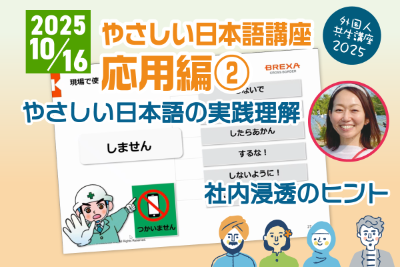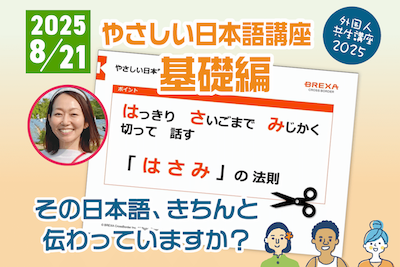- やさしい日本語
- ひらがなをつける
- Language
We provide multilingual content through machine translation. Translation accuracy is not 100%. About the multilingualization of the JAC website
- About JAC
- JAC Membership Information
- Specified Skilled Worker Acceptance
- Specified Skilled Worker Overview of the system
- 10 Mandatory Assistance for Foreigners
- Online individual consultation
- Seminar on Coexistence with Foreign Nationals
- Leading examples of host companies
- Case studies collection "Visionista"
- Foreigner's Voice
- Foreign Resident Acceptance Manual / Q&A
- Useful column "JAC Magazine"
- Acceptance support services
- Specified Skills Acceptance Support Service
- Health and Safety "Online Special Training"
- Safety and health “skills training”
- "Temporary Return Support" to ease the burden
- CCUS charge support
- Free Japanese language courses
- Education and Training Support
- Subsidy system for obtaining qualifications
- Support system for promoting the accumulation of employment history
- "Post-acceptance training" to deepen understanding of the system
- Compensation system for Specified Skilled Worker (i)
- freeJob matching
- The Specified Skills Evaluation Exam
- Home
- JAC Magazine
- JAC Initiatives and Activities Report
- "Foreign Symbiosis Course 2025" for Japan Employees Plain Japanese Lecture (Basics) Report
- Home
- JAC Magazine
- JAC Initiatives and Activities Report
- "Foreign Symbiosis Course 2025" for Japan Employees Plain Japanese Lecture (Basics) Report

"Foreign Symbiosis Course 2025" for Japan Employees Plain Japanese Lecture (Basics) Report

JAC has been holding a total of six seminars for Japan employees since May 2025. On Thursday, August 21, 2025, the third "Basics" of the "Plain Japanese Course" was held online.
This course brushes up on the "Plain Japanese Course" that was well received in FY2024 and reflects the voices of people close to the field.
We will report on the results of the "Plain Japanese Course (Basics)" that are useful in the field.
The lecturer was Mr. Kawamoto of BREXA CrossBorder Co., Ltd.
The first course was held with the goal of "understanding Plain Japanese" that is easy to convey to foreign workers.
*As of July 1, 2025, ORJ Co., Ltd. has changed its name to BREXA CrossBorder Co., Ltd.
Real voices of foreign workers!
The first big change this time was the appearance of Ben, a Filipino, as a guest speaker.
Ben is now fluent in Japanese as an interpreter, but he initially worked in Japan as an Technical Intern Training student. Based on his experience at that time, he talked about what foreign workers were struggling with.
Ben said that in his first year, Technical Intern Training he couldn't understand the content of the instructions from Japan people because he spoke too quickly. He said he was angry because he went ahead with his work, but he didn't understand why the Japanese were angry and the meaning of those words.
And because he didn't understand Japanese, he didn't go out much and spent his time thinking, "I want to go home soon."
It wasn't until his second year that he started to understand a little bit of Japanese. He said that there were Japanese people there who always treated him kindly with a smile, and their demeanor made it easy to ask them questions when he didn't understand something, and that they taught him in simple Japanese, which was what helped him improve his Japanese.
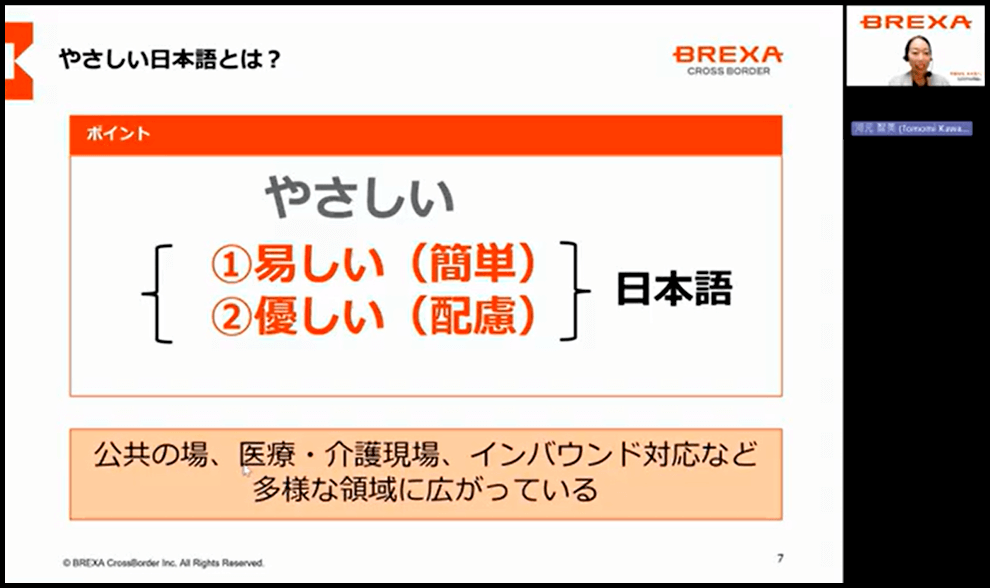
What is Plain Japanese?
Next, the Plain Japanese lecture by Lecturer Kawamoto began.
As a means of communication between people from different cultures, using Plain Japanese has the following benefits.
- Build relationships
- Responding to the multinational nature of the workplace
- Work efficiency
- Improving your own skills
- Reduce interpersonal problems caused by misunderstandings
- Recruitment activities can be carried out regardless of nationality
- Improving the Japanese language skills of foreign workers
- Independence of foreign workers and coexistence with the local community
Certainly, being able to communicate with each other in Japanese will enrich both your work and personal life.
Master the "Scissors" Law!
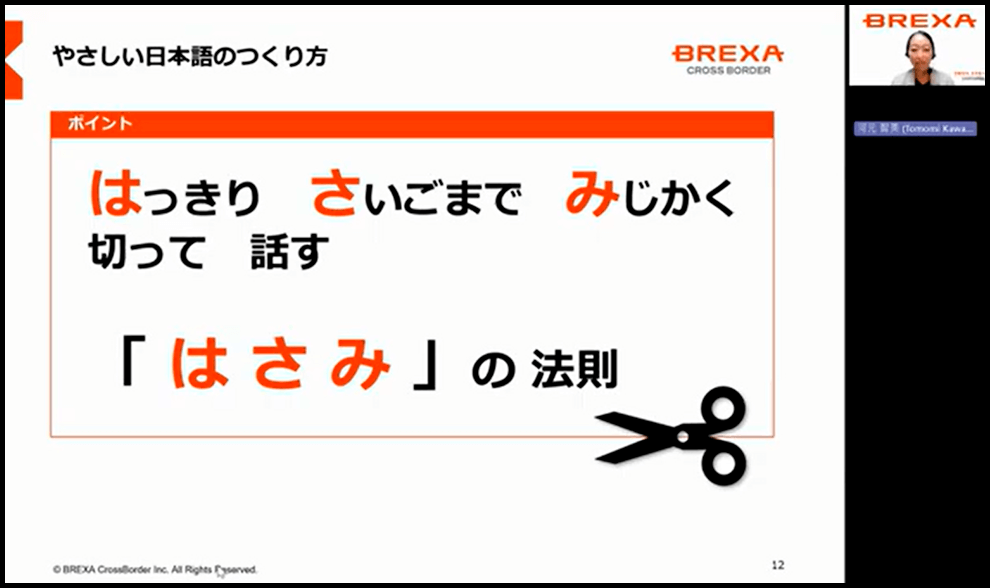
I learned the "scissors" rule, which is the "basic" of how to make Plain Japanese.
"clearly
Until the "sa" sesame
Cut it into "mi" shape
Speaking is the "scissors" rule.
- Communicate clearly and in easy-to-understand words.
- Speak until the end (to the end of the sentence).
- Break sentences into short chunks.
It seems that just by keeping these simple things in mind when speaking, you can greatly increase the other person's understanding.
Check out our archived video to learn how!
Let's make it Plain Japanese!
This course is designed so that viewers can actually try out the concepts rather than just listening to them. Here is one example problem from the course.
"After you've read this paper carefully, write your name here and put it somewhere for now."
If you put this sentence in Plain Japanese, it will look like this:
- Please read this paper.
- Please write your name here.
- Please put it on my desk. (Identify the location clearly, not vaguely.)
It's according to the law of "scissors". According to the instructor, there is no right answer! That's what it means. It seems that Plain Japanese is to make easy and kind words from the heart.
I also learned to avoid Japanese words that have multiple meanings, for example "iiyo" not only means "OK" but also "NO".
As native Japanese speakers, we can understand the meaning from the surrounding words and atmosphere, but it seems to be difficult for foreigners who have just arrived in Japan.
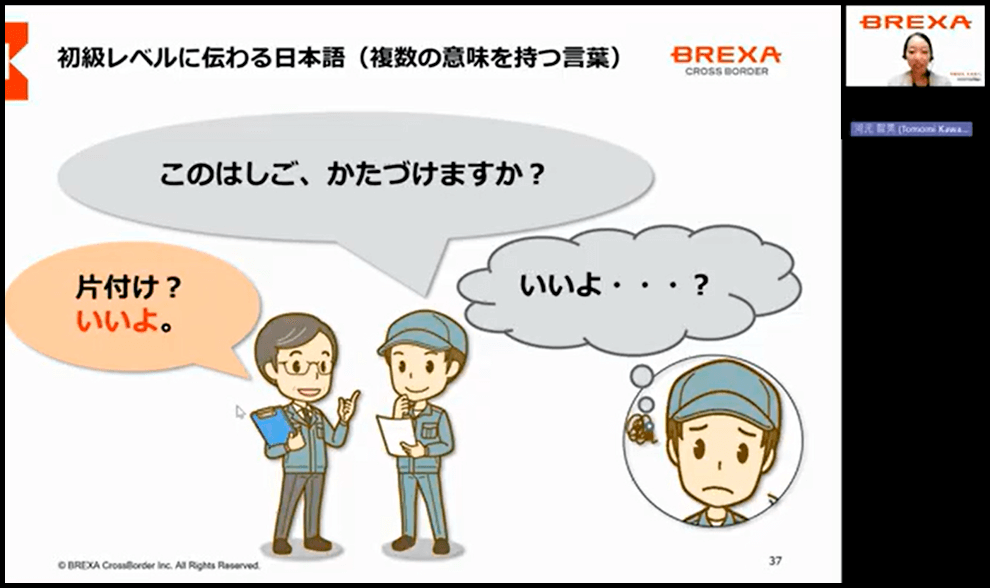
In addition, the practice of changing the "difficult Japanese" in the slide below to "Plain Japanese" was also carried out.
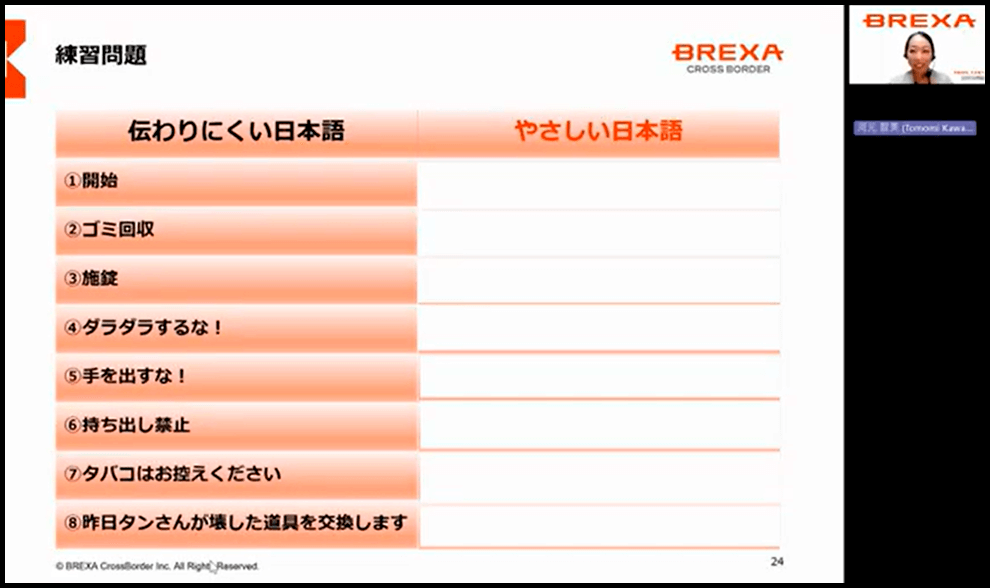
These answers will be available in the archived broadcast around 28:00, so please check it out.
Archived video here
This course also explained other topics such as "how fast should you speak to make your message easier to understand?"
What made the biggest impression on me was the lecturer's words, "Words only have meaning when there is someone to communicate with."
I learned that the basics of Plain Japanese are to be considerate of the other person, speak politely, slowly, and sometimes use gestures, rather than preparing to "convert it to Plain Japanese."
JAC's course on coexistence with foreigners is still ongoing.
Please feel free to join us.
FY2025 "Foreigner Coexistence Course" for Japanese Employees
お問合せ:(株)BREXA CrossBorder 担当:三浦
e-mail:
Tel:
090-3150-0562
This article is a report on the "Plain Japanese Course Basics" of the "Foreign Symbiosis Course 2025" for Japan employees held on Thursday, August 21, 2025.
Seminar Video
Seminar Materials
Seminar Materials_Plain Japanese Lecture (1) Basic Edition 250821.pdf
Q&A_Plain Japanese Lecture (1) Basics 250821.pdf
Report on the "Foreigner Coexistence Seminar" for Japanese Employees
- Report on the "Cross-Cultural Understanding Seminar (1)" for Japanese Employees [1]
- Report on the "Cross-Cultural Understanding Seminar (2) Islam" for Japanese Employees [2]
- For Japan employees [3] "Plain Japanese Course (Basics)" Report
- For Japan employees [4] "Plain Japanese Course (Application (1))" Report
- For Japan employees [5] "Plain Japanese Lecture (Application (2))" Report
I wrote the article!
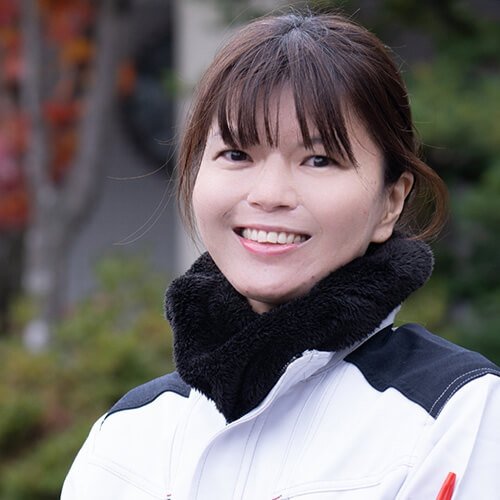
Japan Association for Construction Human Resources Manager, Management Department (and Research Department)
Motoko Kano
Cano Motoko
Born in Aichi Prefecture.
He is in charge of public relations, research and investigation, and is the person behind social media.
We update our social media accounts daily with the desire to make people fall in love with Japan, to spread the appeal of construction from Japan to the world, and to ensure that Japan's construction industry continues to be the industry of choice around the world.
He is also engaged in research into the feasibility of implementing skills evaluation exam in Asian countries, and is conducting interviews with local organizations in each country.
Related articles
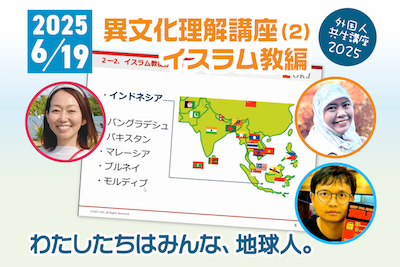
Report on the "Foreigner Coexistence Course 2025" for Japanese Employees: Intercultural Understanding Course (2) Islam
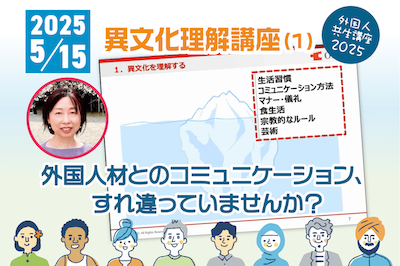
Report on the "Foreigner Coexistence Course 2025" Intercultural Understanding Course (1) for Japanese Employees
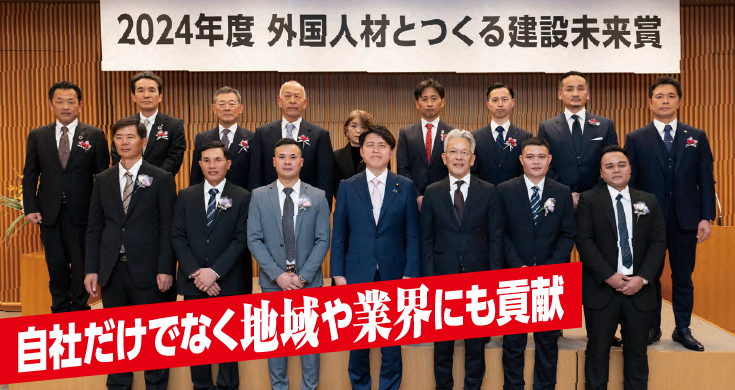
FY2024 "Construction Future Award with Foreign Talent" <Accepting Company/Organization Category> Award Ceremony Report
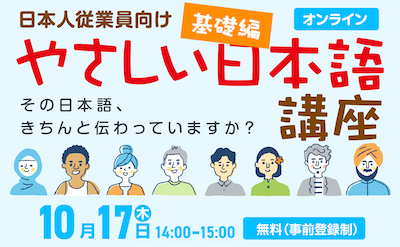
Report on the "Plain Japanese Course Basics" for Japan employees












